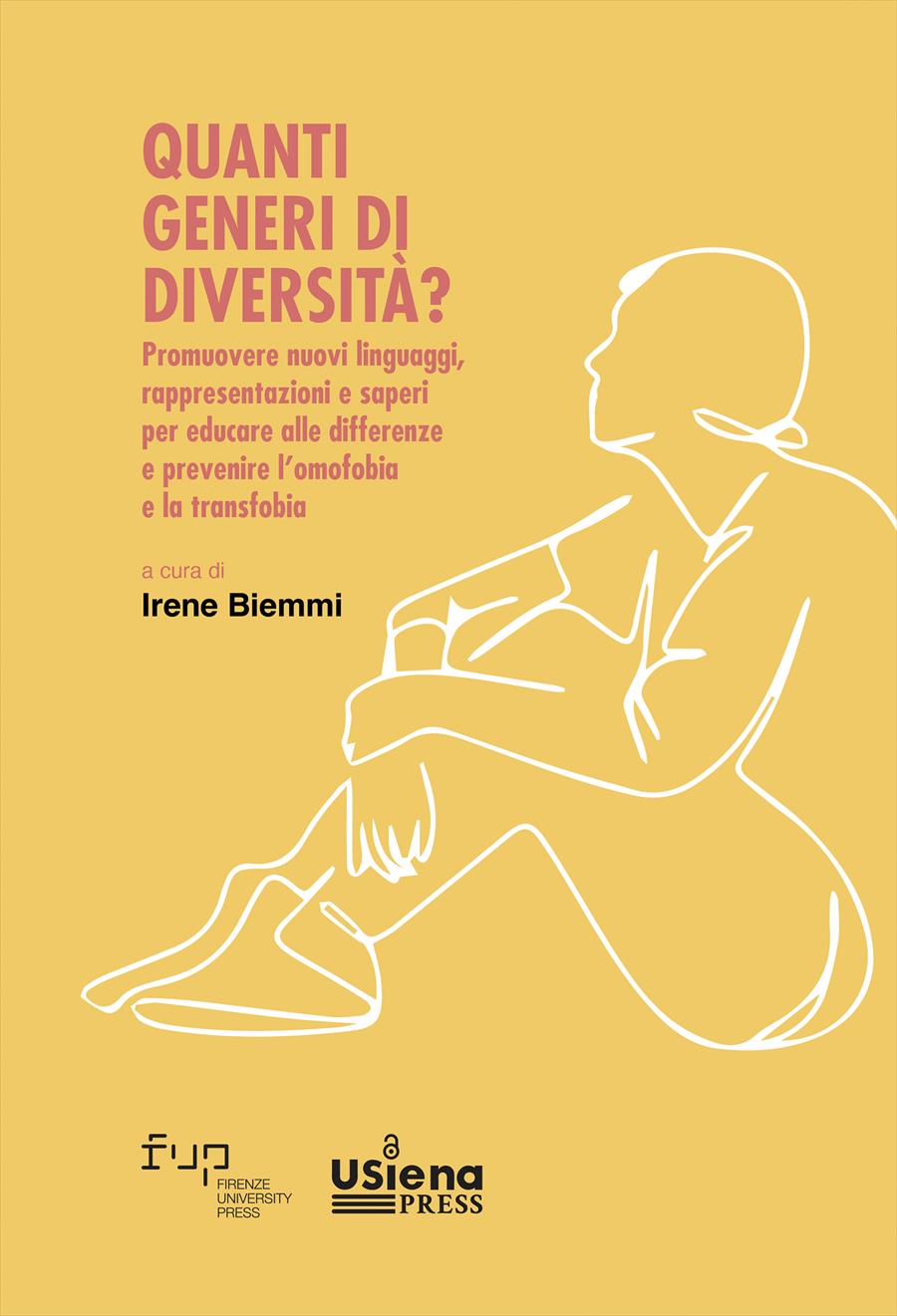- Quanti generi di diversità?
- Edited by Irene Biemmi
Come si rende visibile l’omo-bi-transfobia? Nodi critici, sfide e riflessioni a partire da una ricerca empirica
- Paolo Gusmeroli
- © 2023 Author(s) |
- CC BY-SA 4.0
- DOI: 10.36253/979-12-215-0362-3.07
This contribution intends to reflect on the attempt by social research in Italy to put the spotlight on violence and discrimination against LGBT+ people. The analysis is mainly based on two recent empirical research works: the first focuses on the critical analysis of the discourse on homophobia in Italy, both in the scientific sphere and in the public debate; the second aims at investigating, with a mixed methods survey, violence and discrimination determined by sexual orientation and gender identity in Emilia-Romagna.
- Keywords:
- social research,
- violence,
- discrimination,
- LGBT+,
- Italy,
University of Padua, Italy - ORCID: 0000-0002-6687-5956
- Bettcher, Talia Mae. 2014. “Trapped in a Wrong Theory: Rethinking Trans Oppression and Resistance.” Signs 39, 2: 383-406.
- Bryant, Karl, and Salvador Vidal-Ortiz. 2008. “Introduction to retheorizing homophobias.” Sexualities 11, 4: 387-96.
- Burgio, Giuseppe. 2020. “Una violenza normale: maschilità, adolescenza, omofobia.” Education Sciences & Society 2: 222-37.
- Collins, Patricia Hill. 2019. Intersectionality as Critical Social Theory. Durham and London: Duke University Press.
- Crenshaw, Kimberlé Williams. 1989. “Demarginalizing the Intersection of Race and Sex: A Black Feminist Critique of Anti- Discrimination Doctrine, Feminist Theory and Anti- Racist Politics.” The University of Chicago Legal Forum 1989, Article 8.
- Darwin, Helana. 2020. “Challenging the Cisgender/ Transgender Binary Nonbinary People and the Transgender Label.” Gender & Society 34, 3: 357-80.
- Graglia, Margherita. 2012. Omofobia. Strumenti di analisi e di intervento. Roma: Carocci.
- Gusmeroli, Paolo. 2021. “Inversione dello stigma e aggiornamento delle retoriche anti-lgbt: l’omofobia ‘contesa’ nel discorso mediatico italiano.” AG-AboutGender 10, 19: 268-94.
- Gusmeroli, Paolo, and Luca Trappolin. 2021. “Narratives of Catholic women against ‘Gender ideology’ in Italian schools: defending childhood, struggling with pluralism.” European Societies 23, 4: 513-32.
- Herek, Gregory M. 2004. “Beyond ‘Homophobia’: Thinking About Sexual Prejudice and Stigma in the Twenty-First Century.” Sexuality Research & Social Policy 1, 2: 6-24.
- ISPES. 1991. Il sorriso di Afrodite. Rapporto sulla condizione omosessuale italiana. Firenze: Vallecchi.
- ISTAT. 2012. La popolazione omosessuale nella società italiana, Roma: Istituto Nazionale di Statistica.
- ISTAT-UNAR. 2022. L’indagine ISTAT-UNAR sulle discriminazioni lavorative nei confronti delle persone LGBT+ (in unione civile o già in unione). Anno 2020-2021. Roma: Istituto Nazionale di Statistica.
- Kelly, Liz. 1987. “The continuum of sexual violence.” In Women, violence and social control, edited by Jalna Hanmer, and Mary Maynard, 46-60. Atlantic Heights, NJ: Humanities Press International.
- Kitzinger, Celia. 1987. “Heteropatriarchal language: The case against ‘homophobia’.” Gossip 5, 2: 15-20.
- Lingiardi, Vittorio, et al. 2016. “Homonegativity in Italy: Cultural issues, personality characteristics, and demographic correlates with negative attitudes toward lesbians and gay men.” Sexuality Research and Social Policy 13: 95-108.
- Mauceri, Sergio. 2015. Omofobia come costruzione sociale. Processi generativi del pregiudizio in età adolescenziale. Milano: FrancoAngeli.
- McLean, Kirsten E. 2015. “Inside or Outside? Bisexual Activism and the LGBT Community.” In The Ashgate Research Companion to Lesbian and Gay Activism, edited by David Paternotte, and Manon Tremblay, 149-62. Farnham: Ashgate.
- Meyer, Doug. 2015. Race, Class, Gender, and the Persistence of anti-lgbt Discrimination. New Brunswick: Rutgers University Press.
- Morin, Stephen F., and Ellen M. Garfinkle. 1978. “Male Homophobia.” Journal of Social Issues 34, 1: 29-47.
- Oddone, Cristina. 2020. Uomini normali. Maschilità e violenza nell’intimità. Torino: Rosenberg & Sellier.
- Sabbadini, Linda Laura. 2022. “Indagine conoscitiva sulla natura, cause e sviluppi recenti del fenomeno dei discorsi d’odio, con particolare attenzione alla evoluzione della normativa europea in materia.” Commissione straordinaria per il contrasto dei fenomeni di intolleranza, razzismo, antisemitismo e istigazione all’odio e alla violenza, Senato della Repubblica Roma, 13 aprile 2022.
- Saraceno, Chiara, a cura di. 2003. Diversi da chi? Gay, lesbiche, transessuali in un’area Metropolitana. Milano: Guerini.
- Scott, Joan W. 1991. “The evidence of experience.” Critical Inquiry 17, 14: 773-97.
- Tomsen, Stephen, and Gail Mason. 2001. “Engendering homophobia: Violence, sexuality and gender conformity.” Journal of Sociology 37, 3: 257-73.
- Trappolin, Luca. 2015. “Punire i prepotenti, difendere l’eteronormatività. Un’analisi del dibattito parlamentare italiano sulla violenza omofobica.” Ragion pratica 45: 423-42.
- Trappolin, Luca, e Paolo Gusmeroli. 2019. Raccontare l’omofobia in Italia. Genesi e sviluppi di una parola chiave. Torino: Rosenberg & Sellier.
- Trappolin, Luca, e Paolo Gusmeroli. 2023. Sfidare la norma. Discriminazione e violenza contro le persone LGBTQI+. Padova: Padova University Press.
- Weinberg, George. 1972. Society and the Healthy Homosexual. New York: St. Martin’s Press.
Chapter Information
Chapter Title
Come si rende visibile l’omo-bi-transfobia? Nodi critici, sfide e riflessioni a partire da una ricerca empirica
Authors
Paolo Gusmeroli
Language
Italian
DOI
10.36253/979-12-215-0362-3.07
Peer Reviewed
Publication Year
2023
Copyright Information
© 2023 Author(s)
Content License
Metadata License
Bibliographic Information
Book Title
Quanti generi di diversità?
Book Subtitle
Promuovere nuovi linguaggi, rappresentazioni e saperi per educare alle differenze e prevenire l’omofobia e la transfobia
Editors
Irene Biemmi
Peer Reviewed
Number of Pages
142
Publication Year
2023
Copyright Information
© 2023 Author(s)
Content License
Metadata License
Publisher Name
Firenze University Press, USiena Press
DOI
10.36253/979-12-215-0362-3
ISBN Print
979-12-215-0361-6
eISBN (pdf)
979-12-215-0362-3
eISBN (epub)
979-12-215-0363-0
Series Title
Politiche e strategie per l’uguaglianza di genere e l’inclusione. Temi, ricerche e prospettive dei CUG delle Università di Siena e Firenze
